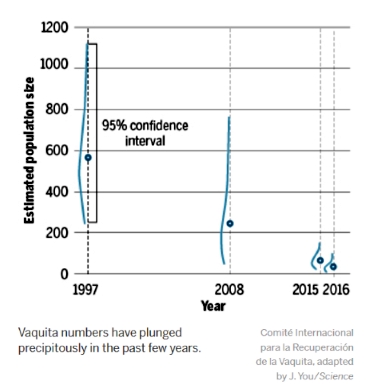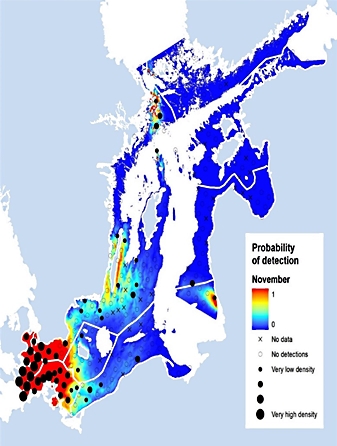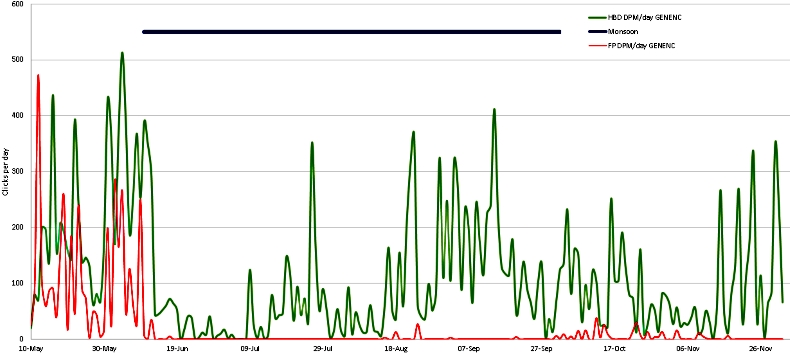Chelonia LimitedWildlife Acoustic Monitoring | ||
Case studiesMonitoring a population trend – the vaquitaThe longest running SAM (static acoustic monitoring) of the population trend of any cetacean.
The vaquita is a species of porpoise found only in Mexican waters in the northern part of the Gulf of California. The Gulf is an acoustically difficult environment with noise from shrimps, sediment transport, common and bottlenose dolphins and weak unknown train sources. A trial and power analysis of possible acoustic monitoring methods was made by Jay Barlow (NOAA) and Armando Jaramillo (CICESE) and the C-POD was selected on account of good sensitivity combined with low false positive rates and low project costs. Instrument losses, mainly due to interaction with fisheries, created data gaps and modelling was used to refine the trend estimates. In this very critical application all automated vaquita detections are visually validated by the Mexican research team. The later estimates shown in the graph opposite are based on C-POD data. They demonstrates the ability of static acoustic monitoring to obtain such large numbers of detections that useful precision can be obtained even from very small populations. SAMBAH: Is the Baltic Harbour Porpoise extinct?The largest acoustic monitoring project on any animal.
SAMBAH and was set up by Mats Amundin and others to establish the status of the massively depleted population of harbour porpoises in the Baltic Sea following the severe decline that occurred in the latter half of the 20th century. Len Thomas (statistical ecologist at the Centre for Research into Ecological and Environmental Modelling at the University of St Andrews) provided statistical design and analysis. C-PODs were moored in a regular grid across the Baltic wherever the water was less than 80 metres deep. As the species is at extremely low density the project faced the conflicting requirements of achieving both high sensitivity and very low false positive rates. A 3-day 6-person workshop held at the Hel Marine Station in Poland established the basis for a Baltic-specific encounter classifier, named 'Hel1' for this task. A 2-day 12-person workshop at the end of SAMBAH validated the performance of this classifier on the actual data sets and found a false positive rate of less than one second per year. (Note: false positives are often expressed as % of true or all positives, but as there is usually no correspondence between false and true positives, and the latter can be zero, rates per year are more appropriate.) SAMBAH-Final-Report-FINAL-for-website-April-2017 Effect of the Indian MonsoonA study of changes in cetacean distribution during the monsoon. A C-POD was deployed in on the west coast of India, and showed a dramatic and sustained drop in detections of the finless porpoise (Neophocaena phocaenoides) from the first few days of the monsoon, with much smaller effects on the detection rate of humpback dolphins (Sousa chinensis). Visual surveys by the Konkan Cetacean Research Team in Maharashtra showed high local densities of the two small cetacean species, but had a gap during the monsoon. 206 days of data were obtained in one data file from a C-POD moored before the monsoon.
The finding indicates substantial seasonal redistribution of finless porpoises. Thanks to Dipani Sutaria, Ketki Jog, Mihir Sule, Isha Bopardikar for this data. Seismic surveysShort term porpoise disturbance does not lead to long term displacement. Marine wind farm constructionPorpoise displacement by construction noise far exceeded expectations. Habitat use by Hector’s DolphinT-POD data used to define a protected area. For further information on these and other C-POD projects see the PODs and acoustics page.
|
||
 An
array of 49 C-PODs is deployed each year to monitor the fast-declining
vaquita (Phocoena sinus) population. The results have triggered the difficult decision to try
to capture the last few before they are lost to bycatch.
An
array of 49 C-PODs is deployed each year to monitor the fast-declining
vaquita (Phocoena sinus) population. The results have triggered the difficult decision to try
to capture the last few before they are lost to bycatch. The
SAMBAH project deployed C-PODs in a grid across the shallower parts of the
Baltic for 2 years. 12,000TB of data were processed at sea by the C-PODs and
0.5TB brought ashore in 1400 data files. The detection function was assessed
and a population estimate made. Distinct hotspots and seasonal patterns were
found and three Marine Conservation Zones have been proposed. Previously
even the continued existence of the sub-species was in doubt.
The
SAMBAH project deployed C-PODs in a grid across the shallower parts of the
Baltic for 2 years. 12,000TB of data were processed at sea by the C-PODs and
0.5TB brought ashore in 1400 data files. The detection function was assessed
and a population estimate made. Distinct hotspots and seasonal patterns were
found and three Marine Conservation Zones have been proposed. Previously
even the continued existence of the sub-species was in doubt.
